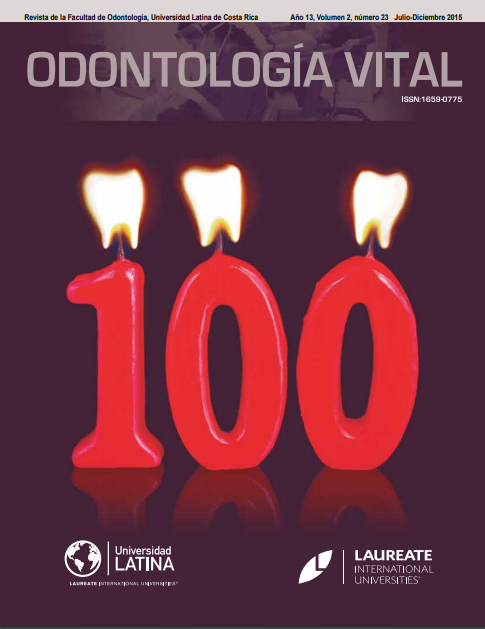Stereolithography and computer planning in maxillofacial surgery
DOI:
https://doi.org/10.59334/ROV.v2i23.266Keywords:
Maxillofacial, stereolithography, 3D model, computer planningAbstract
Stereolithography is the method of printing a tridimensional model, based on the information from tomographic images, used as a tool of diagnosis and surgical treatment plan.
The purpose of this paper is to show the usefulness of 3D models and surgical computer planning, in the different fields of maxillofacial surgery. A literature review is performed, clinical cases are presented and the value of this technology in our surgical specialty is analyzed.
Downloads
References
Bill JS et ál. (1995) Stereolithography in oral and maxillofacial operation planning. Int J. Oral Maxillofac Surg 24: 98-103. https://doi.org/10.1016/S0901-5027(05)80869-0
Chow, L.K., Cheung, L.K. (2007) The Usefulness of Stereomodels in Maxillofacial Surgical Management. J. Oral Maxillofac Surg 65:2260-2268. https://doi.org/10.1016/j.joms.2006.11.041
Cunningham, L., Madsen, M.J., Peterson, G. (2005) Stereolithographic Modeling Techonology Applied to tumor Resection. J. Oral Maxillofac Surg 63: 873-878. https://doi.org/10.1016/j.joms.2005.02.027
Dolz, M.S., Cina, S.J., Smith, R. (2000) Stereolithography. A Potential New Tool in Forensic Medicine. The American Journal of Forensic Medicine and Pathology 21(2) 119-123. https://doi.org/10.1097/00000433-200006000-00005
Erickson, D.M., Chance, D., Schmitt, S., Mathis, J. (1999) An opinion survey of reported benefits from the use of Stereolithographic Models. J Oral Maxillofac Surg 5; 1040-1043. https://doi.org/10.1016/S0278-2391(99)90322-1
Jiménez R., Benavides A. (2005) La estereolitografía en la Facultad de Odontología de la UNAM. Revista Odontológica Mexicana. Vol.9 Núm 1: pp48-50.
Kermer, C., et al. (1998) Preoperative stereolithographic model planning for primary reconstruction in cranio-maxillofacial trauma surgery. Journal of Cranio-Maxillofacial Surgery 136-139. https://doi.org/10.1016/S1010-5182(98)80002-4
Kermer, C. et al. (1998) Colour stereolithography for planning complex maxillofacial tumour surgery. Journal of Cranio-Maxillofacial Surgery 26, 360-362. https://doi.org/10.1016/S1010-5182(98)80068-1
Kernan, B.T., Wimsatt III, J.A. (2000) Use of a Stereolithography Model for Accurate, Preoperative Adaptation of Reconstruction Plate. J Oral Maxillofac Surg 58: 349-351. https://doi.org/10.1016/S0278-2391(00)90071-5
McGurk et al. (1997) Rapid prototyping techniques for anatomical modelling in medicine. Ann R Coll Surg Engl; 79: 169-174
Nikzad, S., Azari, A., (2008) A novel Stereolithographic Surgical Guide Template for Planning Treatment involving a Mandibular Dental Implant. J. Oral Maxillofac Surg 66: 1446-1454. https://doi.org/10.1016/j.joms.2008.03.004
Politi M. et al. (2007) Feasibility of preoperative planning using anatomical facsimile models for mandibular reconstruction. Head and Face Medicine. 3 (5). https://doi.org/10.1186/1746-160X-3-5
Sailer et al. (1998) The value of stereolithographic models for preoperative diagnosis of craniofacial deformities and planning of surgical corrections. Int. J. Oral Maxillofac Surg; 27: 327-333. https://doi.org/10.1016/S0901-5027(98)80059-3
Sinn, D.P., Cilio, J.E., Miles, B.A. (2006) Stereolithography for Craniofacial Surgery. The Journal of Craniofacial Surgery; 17(5). https://doi.org/10.1097/01.scs.0000230618.95012.1d
Winder J., Bibb R. (2005) Medical Rapid Prototyping Technologies: State of the Art and Current Limitations for Application in Oral and Maxillofacial Surgery. J. Oral Maxillofac Surg 63: 1006-1015. https://doi.org/10.1016/j.joms.2005.03.016
Wong, T.J., Chung, C.H., Huang, J.S. (2002) Restoration of the Temporal Defect using Laser Stereolithography Technique. J. Oral Maxillofac Surg 60: 1374-1376. https://doi.org/10.1053/joms.2002.35755
Xia, J., Gateno, J., Teichgraeber, J.F. A (2009) New Paradigm for Complex Midface Reconstruction: A Reversed Approach. J Oral Maxillofac Surg 67; 693-703. https://doi.org/10.1016/j.joms.2008.08.024
Downloads
Published
Issue
Section
License
Copyright (c) 2015 Gustavo Vargas-Soto, Rodrigo Licéaga-Reyes

This work is licensed under a Creative Commons Attribution 4.0 International License.
Authors who publish with Odontología Vital agree to the following terms:
- Authors retain the copyright and grant Universidad Latina de Costa Rica the right of first publication, with the work simultaneously licensed under a Creative Commons Attribution 4.0 International license (CC BY 4.0) that allows others to share the work with an acknowledgement of the work's authorship and initial publication in this journal.
- Authors are able to enter into separate, additional contractual arrangements for the non-exclusive distribution of the Odontología Vital's published version of the work (e.g., post it to an institutional repository or publish it in a book), with an acknowledgement of its initial publication.
- Authors are permitted and encouraged to post their work online (e.g., in institutional repositories or on their website) prior to and during the submission process, as it can lead to productive exchanges, as well as earlier and greater citation of published work.







